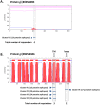Clusters versus affinity-based approaches in F. tularensis whole genome search of CTL epitopes
- PMID: 22563500
- PMCID: PMC3341354
- DOI: 10.1371/journal.pone.0036440
Clusters versus affinity-based approaches in F. tularensis whole genome search of CTL epitopes
Abstract
Deciphering the cellular immunome of a bacterial pathogen is challenging due to the enormous number of putative peptidic determinants. State-of-the-art prediction methods developed in recent years enable to significantly reduce the number of peptides to be screened, yet the number of remaining candidates for experimental evaluation is still in the range of ten-thousands, even for a limited coverage of MHC alleles. We have recently established a resource-efficient approach for down selection of candidates and enrichment of true positives, based on selection of predicted MHC binders located in high density "hotspots" of putative epitopes. This cluster-based approach was applied to an unbiased, whole genome search of Francisella tularensis CTL epitopes and was shown to yield a 17-25 fold higher level of responders as compared to randomly selected predicted epitopes tested in Kb/Db C57BL/6 mice. In the present study, we further evaluate the cluster-based approach (down to a lower density range) and compare this approach to the classical affinity-based approach by testing putative CTL epitopes with predicted IC(50) values of <10 nM. We demonstrate that while the percent of responders achieved by both approaches is similar, the profile of responders is different, and the predicted binding affinity of most responders in the cluster-based approach is relatively low (geometric mean of 170 nM), rendering the two approaches complimentary. The cluster-based approach is further validated in BALB/c F. tularensis immunized mice belonging to another allelic restriction (Kd/Dd) group. To date, the cluster-based approach yielded over 200 novel F. tularensis peptides eliciting a cellular response, all were verified as MHC class I binders, thereby substantially increasing the F. tularensis dataset of known CTL epitopes. The generality and power of the high density cluster-based approach suggest that it can be a valuable tool for identification of novel CTLs in proteomes of other bacterial pathogens.
Conflict of interest statement
Figures






Similar articles
-
Protective immunity against lethal F. tularensis holarctica LVS provided by vaccination with selected novel CD8+ T cell epitopes.PLoS One. 2014 Jan 6;9(1):e85215. doi: 10.1371/journal.pone.0085215. eCollection 2014. PLoS One. 2014. PMID: 24400128 Free PMC article.
-
Whole-genome immunoinformatic analysis of F. tularensis: predicted CTL epitopes clustered in hotspots are prone to elicit a T-cell response.PLoS One. 2011;6(5):e20050. doi: 10.1371/journal.pone.0020050. Epub 2011 May 20. PLoS One. 2011. PMID: 21625462 Free PMC article.
-
A broadly applicable approach to T cell epitope identification: application to improving tumor associated epitopes and identifying epitopes in complex pathogens.J Immunol Methods. 2011 Oct 28;373(1-2):111-26. doi: 10.1016/j.jim.2011.08.007. Epub 2011 Aug 18. J Immunol Methods. 2011. PMID: 21872603 Free PMC article.
-
An approach to the identification of T cell epitopes in the genomic era: application to Francisella tularensis.Immunol Res. 2009 Dec;45(2-3):218-28. doi: 10.1007/s12026-009-8103-z. Epub 2009 Feb 11. Immunol Res. 2009. PMID: 19212707 Free PMC article. Review.
-
Identification of a dominant CD4 T cell epitope in the membrane lipoprotein Tul4 from Francisella tularensis LVS.Mol Immunol. 2009 May;46(8-9):1830-8. doi: 10.1016/j.molimm.2009.01.008. Epub 2009 Feb 23. Mol Immunol. 2009. PMID: 19233475 Free PMC article.
Cited by
-
Protective immunity against lethal F. tularensis holarctica LVS provided by vaccination with selected novel CD8+ T cell epitopes.PLoS One. 2014 Jan 6;9(1):e85215. doi: 10.1371/journal.pone.0085215. eCollection 2014. PLoS One. 2014. PMID: 24400128 Free PMC article.
-
Tularaemia: a challenging zoonosis.Comp Immunol Microbiol Infect Dis. 2014 Mar;37(2):85-96. doi: 10.1016/j.cimid.2014.01.002. Epub 2014 Jan 13. Comp Immunol Microbiol Infect Dis. 2014. PMID: 24480622 Free PMC article. Review.
-
Peptide-based vaccinology: experimental and computational approaches to target hypervariable viruses through the fine characterization of protective epitopes recognized by monoclonal antibodies and the identification of T-cell-activating peptides.Clin Dev Immunol. 2013;2013:521231. doi: 10.1155/2013/521231. Epub 2013 Jun 26. Clin Dev Immunol. 2013. PMID: 23878584 Free PMC article. Review.
-
Integrated computational prediction and experimental validation identifies promiscuous T cell epitopes in the proteome of Mycobacterium bovis.Microb Genom. 2016 Aug 25;2(8):e000071. doi: 10.1099/mgen.0.000071. eCollection 2016 Aug. Microb Genom. 2016. PMID: 28348866 Free PMC article.
References
-
- Hepburn MJ, Simpson AJ. Tularemia: current diagnosis and treatment options. Expert Rev Anti Infect Ther. 2008;6:231–240. - PubMed
-
- Sjostedt A. Intracellular survival mechanisms of Francisella tularensis, a stealth pathogen. Microbes Infect. 2006;8:561–567. - PubMed
-
- Titball RW, Petrosino JF. Francisella tularensis genomics and proteomics. Ann N Y Acad Sci. 2007;1105:98–121. - PubMed
-
- Conlan JW. Tularemia vaccines: recent developments and remaining hurdles. Future Microbiol. 2011;6:391–405. - PubMed
Publication types
MeSH terms
Substances
LinkOut - more resources
Full Text Sources
Other Literature Sources
Research Materials
Miscellaneous

